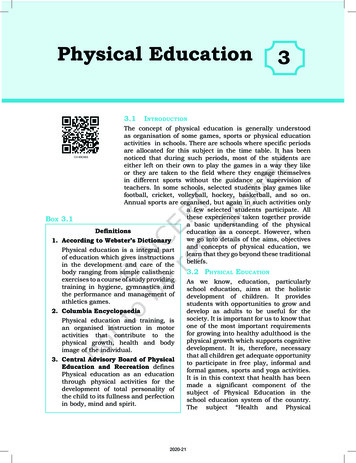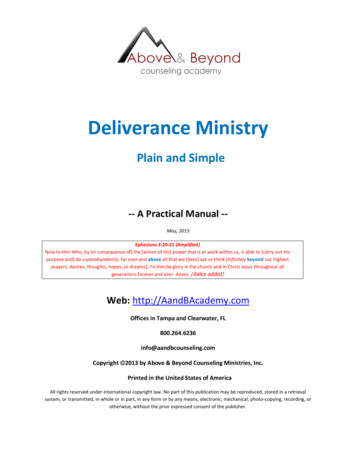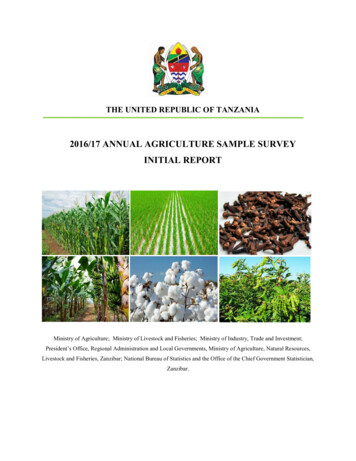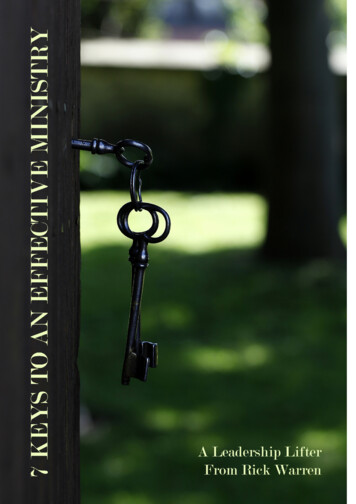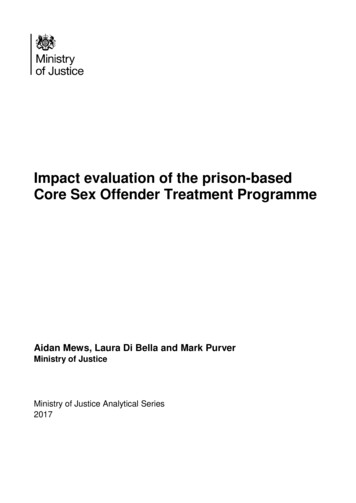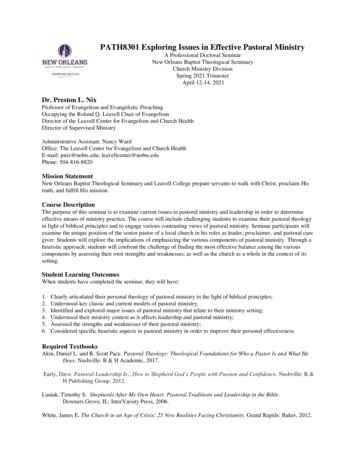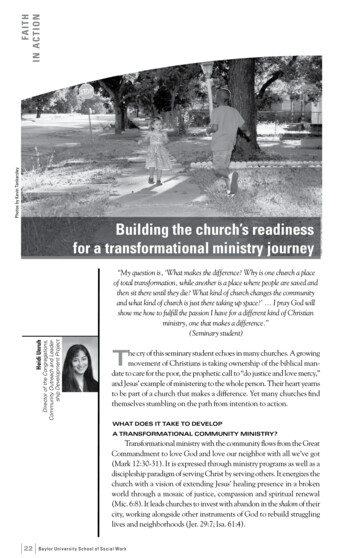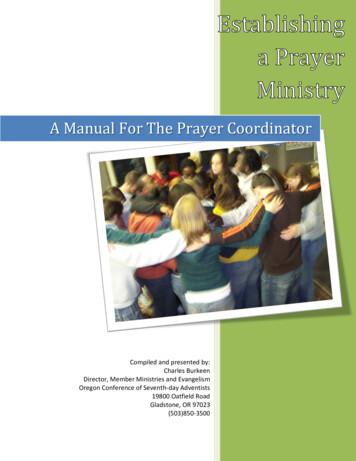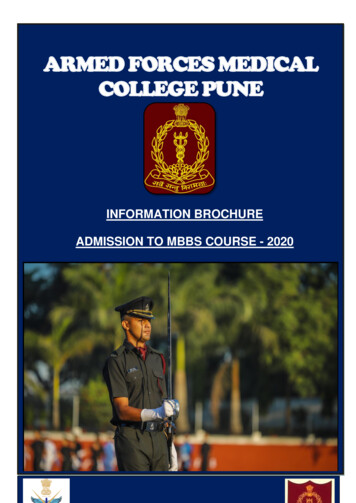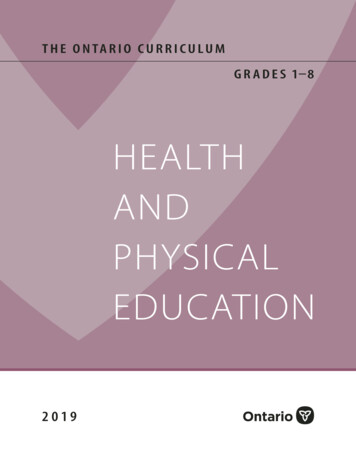
Transcription
T H E O N TA R I O C U R R I C U L U MG R A D E S 1–8HEALTHANDPHYSICALEDUCATION2019
The Ontario Public Service endeavours to demonstrate leadership with respect to accessibility in Ontario.Our goal is to ensure that Ontario government services, products, and facilities are accessible to all ouremployees and to all members of the public we serve. This document, or the information that it contains,is available, on request, in alternative formats. Please forward all requests for alternative formats toServiceOntario at 1-800-668-9938 (TTY: 1-800-268-7095).19-001ISBN 978-1-4868-3446-4 (PDF) Queen’s Printer for Ontario, 2019
ContentsPreface 3Elementary Schools for the Twenty-First Century 3Supporting Students’ Well-Being and Ability to Learn 3Introduction 6Vision and Goals of the Health and Physical Education Curriculum 6The Importance of the Health and Physical Education Curriculum 7Fundamental Principles in Health and Physical Education 9Foundations for a Healthy School 10Roles and Responsibilities in Health and Physical Education 13The Program in Health and Physical Education 21Curriculum Expectations 21The Strands in the Health and Physical Education Curriculum 24Assessment and Evaluation of Student Achievement 45Basic Considerations 45The Achievement Chart for Health and Physical Education 49Some Considerations for Program Planning in Healthand Physical Education 54Instructional Approaches and Teaching Strategies 54Health and Safety in Health and Physical Education 61Cross-Curricular and Integrated Learning 64Planning Health and Physical Education Programs for Students withSpecial Education Needs 65Program Considerations for English Language Learners 69Une publication équivalente est disponible en français sous le titre suivant : Le curriculum de l’Ontario de la 1reà la 8e année – Éducation physique et santé, 2019.This publication is available on the Ministry of Education’s website, at www.edu.gov.on.ca.
Environmental Education and Health and Physical Education 72Healthy Relationships and Health and Physical Education 73Equity and Inclusive Education in Health and Physical Education 75Financial Literacy in Health and Physical Education 77Literacy, Inquiry Skills, and Numeracy in Health and Physical Education 78The Role of the School Library in Health and Physical Education Programs 83The Role of Information and Communications Technology in Healthand Physical Education 84Education and Career/Life Planning through the Health andPhysical Education Curriculum 85Ethics in the Health and Physical Education Program 86Overview of Grades 1 to 3 89Grade 1 93Grade 2 111Grade 3 131Overview of Grades 4 to 6 153Grade 4 157Grade 5 183Grade 6 207Overview of Grades 7 and 8 233Grade 7 237Grade 8 265Appendices 291Appendix A. Social-Emotional Learning Skills Summary, with References 292Appendix B. Active Living Summary: Key Topics 297Appendix C. Movement Competence Learning Summary: Skills, Concepts,and Strategies 298Appendix D. Healthy Living Learning Summary: Key Topics 299Glossary 303
PrefaceThis document replaces The Ontario Curriculum, Grades 1–8: Health and Physical Education,Interim Edition, re-issued in 2018. Beginning in September 2019, all health and physicaleducation programs for Grades 1 to 8 will be based on the expectations outlined in thisdocument.Elementary Schools for the Twenty-First CenturyOntario elementary schools strive to support high-quality learning while giving everystudent the opportunity to learn in the way that is best suited to their individual strengthsand needs. The Ontario curriculum is designed to help all students reach their full potentialthrough a program of learning that is coherent, relevant, and age-appropriate. It recognizesthat, today and in the future, students need to be critically literate in order to synthesizeinformation, make informed decisions, communicate effectively, and thrive in an everchanging global community. It is important for students to be connected to the curriculum;to see themselves in what is taught, how it is taught, and how it applies to the world at large.The curriculum recognizes that the needs of learners are diverse, and helps all learnersdevelop the knowledge, skills, and perspectives they need to become informed, productive,caring, responsible, healthy, and active citizens in their own communities and in the world.Supporting Students’ Well-Being and Ability to LearnPromoting the healthy development of all students, as well as enabling all students to reachtheir full potential, is a priority for educators across Ontario. Students’ health and wellbeing contribute to their ability to learn in all disciplines, including health and physicaleducation, and that learning in turn contributes to their overall well-being. A well-roundededucational experience prioritizes social-emotional learning, physical and mental health,and inclusion together with academic success for all students. Parents, community partners,and educators all have critical roles in achieving this. The health and physical educationcurriculum engages students in learning about the factors that contribute to health andwell-being and in building skills to live healthy, active lives.Educators promote children and youth’s well-being by creating, fostering, and sustaininga learning environment that is healthy, caring, safe, inclusive, and accepting. A learningenvironment of this kind will support not only students’ cognitive, emotional, social, andphysical development but also their mental health, their resilience, and their overall stateof well-being. All this will help them achieve their full potential in school and in life.Preface3
A variety of factors, known as the “determinants of health” (discussed in this documenton page 12), have been shown to affect a person’s overall state of well-being. Some of theseare income and social status, education and literacy, gender, culture, physical environments,social supports and coping skills, and access to health services. Together, such factorsinfluence not only whether a person is physically healthy but also the extent to whichthey will have the physical, social, and personal resources needed to cope and to identifyand achieve personal aspirations. These factors also have an impact on student learning,and it is important to be aware of them as factors contributing to a student’s performance.An educator’s awareness of and responsiveness to students’ cognitive, emotional, social,and physical development, and to their sense of self, or spirit, is critical to their successin school. A number of research-based frameworks, including those described in EarlyLearning for Every Child Today: A Framework for Ontario Early Childhood Settings(2007), On My Way: A Guide to Support Middle Years Childhood Development (2017),and Stepping Stones: A Resource on Youth Development (2012),1 identify developmentalstages that are common to the majority of students from Kindergarten to Grade 12. At thesame time, these frameworks recognize that individual differences, as well as differencesin life experiences and exposure to opportunities, can affect development, and that deve lopmental events are not specifically age-dependent.The framework described in Stepping Stones is based on a model that illustrates thecomplexity of human development. Its components – the cognitive, emotional, physical,and social domains – are interrelated and interdependent, and all are subject to the influence of a person’s environment or context. At the centre is an “enduring (yet changing)core” – a sense of self, or spirit – that connects the different aspects of development andexperience (p. 17).1. Best Start Expert Panel on Early Learning, Early Learning for Every Child Today: A Framework for Ontario EarlyChildhood Settings (2007), Ministry of Children and Youth Services, On My Way: A Guide to Support Middle YearsChild Development (2017), and Government of Ontario, Stepping Stones: A Resource on Youth Development (2012).4HEALTH AND PHYSICAL EDUCATION, 2019 The Ontario Curriculum, Grades 1–8
The Role of Mental HealthMental health touches all components of development. As students will learn in the program outlined in this document, mental health is much more than the absence of mentalillness. Well-being is influenced not only by the absence of problems and risks but by thepresence of factors that contribute to healthy growth and development. By nurturing andsupporting students’ strengths and assets, educators help promote positive mental healthin the classroom. At the same time, they can identify students who need additional support and connect them with the appropriate supports and services.2What happens at school can have a significant influence on a student’s well-being. With abroader awareness of mental health, educators can plan instructional strategies that contribute to a supportive classroom climate for learning in all subject areas, build awarenessof mental health, and reduce stigma associated with mental illness. Taking students’ wellbeing, including their mental health, into account when planning instructional approacheshelps establish a strong foundation for learning.2. F or more information, see the ministry document Supporting Minds: An Educator’s Guide to Promoting Students’Mental Health and Well-being (2013); see also pages 41 and 44 in this document.Preface5
IntroductionThe 2019 health and physical education curriculum includes updated expectations in anumber of areas, including mental health. Opportunities to learn about mental healthare enhanced through the inclusion of new expectations on mental health literacy; newexpectations on social-emotional learning skills, to be taught in connection with allparts of the curriculum; and enhanced connections to mental health within existingcurriculum expectations.Vision and Goals of the Health and Physical Education CurriculumThe health and physical education curriculum is based on the vision that theknowledge and skills students acquire in the program will benefit them throughouttheir lives and enable them to thrive in an ever-changing world by helping themdevelop mental health and well-being, physical and health literacy, and the compre hension, capacity, and commitment they will need to lead healthy, active lives andpromote healthy, active living.The goals of the health and physical education program are as follows.Students will develop: the social-emotional learning skills needed to foster overall health and well-being,positive mental health, and the ability to learn, build resilience, and thrive;the skills and knowledge that will enable them to enjoy being active and healthythroughout their lives, through opportunities to participate regularly and safely inphysical activity and to learn how to develop and improve their own personal fitness;the movement competence needed to participate in a range of physical activities,through opportunities to develop movement skills and to apply movement conceptsand strategies in games, sports, dance, and various other physical activities;an understanding of the factors that contribute to healthy development, a sense ofpersonal responsibility for lifelong health, and an understanding of how living healthy,active lives is connected with the world around them and the health of others.The knowledge and skills acquired in health education and physical education form anintegrated whole that relates to the everyday experiences of students and provides themwith the physical literacy and health literacy they need to lead healthy, active lives.6HEALTH AND PHYSICAL EDUCATION, 2019 The Ontario Curriculum, Grades 1–8
Physical LiteracyIndividuals who are physically literate move with competence and confidence in awide variety of physical activities in multiple environments that benefit the healthydevelopment of the whole person. Physically literate individuals consistently develop the motivation and ability tounderstand, communicate, apply, and analyze different forms of movement.They are able to demonstrate a variety of movements confidently, competently,creatively and strategically across a wide range of health-related physical activities.These skills enable individuals to make healthy, active choices that are bothbeneficial to and respectful of their whole self, others, and their environment.Physical and Health Education CanadaHealth LiteracyHealth literacy involves the skills needed to get, understand and use information tomake good decisions for health. The Canadian Public Health Association’s ExpertPanel on Health Literacy defines it as the ability to access, understand, evaluate andcommunicate information as a way to promote, maintain and improve health in avariety of settings across the life-course.Irving Rootman and Deborah Gordon-El-Bihbety, A Vision for aHealth Literate Canada: Report of the Expert Panel on Health Literacy(Ottawa: Canadian Public Health Association, 2008).The Importance of the Health and Physical Education CurriculumThis curriculum helps students develop an understanding of what they need in order tomake a commitment to lifelong healthy, active living and develop the capacity to live satisfying, productive lives. Healthy, active living benefits both individuals and society in manyways – for example, by increasing productivity and readiness for learning, improving morale,decreasing absenteeism, reducing health-care costs, decreasing anti-social behaviour suchas bullying and violence, promoting safe and healthy relationships, and heightening personalsatisfaction. Research has shown a connection between increased levels of physical activityand better academic achievement, better concentration, better classroom behaviour, andmore focused learning. Other benefits include improvements in mental health and wellbeing, physical capacity, self-concept, and the ability to cope with stress. The expectationsthat make up this curriculum also provide the opportunity for students to develop socialemotional learning skills and well-being. This practical, balanced approach will help students move successfully through elementary and secondary school and beyond. In healthand physical education, students will learn the skills needed to be successful in life asactive, healthy, and socially responsible citizens.Introduction7
The health and physical education curriculum promotes important educational values andgoals that support the development of character. These include striving to achieve one’spersonal best, equity and fair play, respect for diversity, sensitivity and respect for individual requirements and needs, and good health and well-being. These values are reinforcedin other curriculum areas, as well as by society itself. Working together, schools and communities can be powerful allies in motivating students to achieve their potential and leadhealthy, active lives.The content and the setting of learning in health and physical education make it uniquein a student’s school experience. Students are given opportunities to learn by doing.Their experiences in the program can include participating kinesthetically in activitiesin a gymnasium, in open spaces in the school, and outdoors; working with various typesof equipment; working in a variety of group contexts; and discussing topics that havedeep personal relevance and meaning. Students have opportunities to learn throughcreative work, collaboration, and hands-on experiences.8HEALTH AND PHYSICAL EDUCATION, 2019 The Ontario Curriculum, Grades 1–8
Fundamental Principles in Health and Physical EducationThe health and physical education curriculum from Grade 1 to Grade 12 is founded onthe following principles. 31. Health and physical education programs are most effective when they are deliveredin healthy schools and when students’ learning is supported by school staff, families,and communities.When students see the concepts they are learning in health and physical educationreflected and reinforced through healthy-school policies and healthy practices in theirfamilies and communities, their learning is validated and reinforced. Students are thenmore likely to adopt healthy active living practices and maintain them throughouttheir lives.2. Physical activity is the key vehicle for student learning.Health and physical education offers students a unique opportunity for kinestheticlearning – they learn about healthy, active living primarily by “doing”, that is, throughphysical activity. In health and physical education, students discover the joy of movement, learn about their bodies, and develop physical and cognitive skills that willcontribute to their lifelong health and well-being.3. Physical and emotional safety is a precondition for effective learning in health andphysical education.Students learn best in an environment that is physically and emotionally safe. Inhealth and physical education, students are learning new skills and participating in aphysical environment where there is inherent risk. They are learning in a public spacewhere others can see them explore, learn, succeed, and make mistakes. They discusshealth topics that have implications for their personal health and well-being. It is criticalthat teachers provide a physically and emotionally safe environment for learning byemphasizing the importance of safety in physical activity, treating students with respectat all times, being sensitive to individual differences, following all board safety guidelines, and providing an inclusive learning environment that recognizes and respectsthe diversity of all students and accommodates individual strengths, needs, andinterests.4. Learning in health and physical education is student-centred and skill-based.Learning in health and physical education should be directly connected to the needsand abilities of individual students. The curriculum expectations are age-relatedbut not age-dependent – the readiness of students to learn will depend on their individual physical and emotional development. The learning in all strands is focused3. The Grade 11 and 12 destination courses integrate these principles while also focusing on specialized topics.Introduction9
on individual skill development for healthy, active living, supported by knowledge ofcontent and conceptual understanding. In order to reach their full potential, studentsneed to receive progressive instruction and constructive feedback, as well as numerousopportunities to practise, reflect, and learn experientially in a safe environment.5. Learning in health and physical education is balanced, integrated, and connectedto real life.Health and physical education is balanced in that it addresses both the physical andcognitive needs of students. It also addresses their emotional and social needs. It isimportant for teachers to provide adequate time and resources for all aspects of theprogram, and not to allow any one aspect to be emphasized at the expense of others.Learning in health and physical education is integrated because the connec tionsbetween the various elements of the program – social-emotional learning skills,active living, movement competence, and healthy living – are always recognized.Understanding these connections provides the foundation for health and physicalliteracy, overall mental health and well-being, and lifelong healthy, active living.Finally, health and physical education is highly relevant to students’ present and futurelives in a complex, global, technology-rich, and rapidly changing world, and studentsneed to understand this if they are to develop the comprehension, commitment,and capacity to participate in and promote healthy, active living.Foundations for a Healthy SchoolStudents’ learning in health and physical education helps them make informed decisionsabout all aspects of their health and encourages them to lead healthy, active lives. Thislearning is most authentic and effective when it occurs within the context of a “healthy”school. The implementation of the health and physical education curriculum is a significant component of a healthy learning environment that supports well-being.The Ministry of Education’s Foundations for a Healthy School identifies five interconnected areas that together inform a comprehensive approach to developing a healthierschool. (The five areas align closely with the K 12 School Effectiveness Framework.)This comprehensive approach ensures that students learn about healthy, active living inan environment that reinforces their learning through policies, programs, and initiativesthat promote healthy, active living. The five areas are as follows: 10Curriculum, Teaching, and LearningSchool and Classroom LeadershipStudent EngagementSocial and Physical EnvironmentsHome, School, and Community PartnershipsHEALTH AND PHYSICAL EDUCATION, 2019 The Ontario Curriculum, Grades 1–8
Curriculum, Teaching, and LearningThe implementation of the health and physical education curriculum provides studentswith a wide range of opportunities to learn, practise, and demonstrate knowledge andskills related to healthy and active living. Instruction and implementation of the curriculumcan lay the foundation for students to make choices that support healthy, active livingoutside instructional time. In order to ensure effective health and physical educationprograms, it is important for teachers and school administrators to participate in focusedprofessional learning opportunities.School and Classroom LeadershipSchool and classroom leadership focuses on creating a positive classroom and schoolenvironment by identifying shared goals and priorities that are responsive to the needsof the school community. This can include integrating healthy schools policies and programs into school improvement planning processes; establishing a collaborative learningculture that fosters innovation; ensuring that policies and procedures related to studentwell-being are in place; and collecting and using data to identify priorities and informprogramming.Student EngagementStudent engagement refers to students identifying with and valuing their learning; feelinga sense of belonging at school; and being informed about, engaged with, and empoweredto participate in and lead academic and non-academic activities. Student engagement isstrengthened when opportunities are provided for students to take leadership roles in relation to their learning, the learning environment, and their well-being; when students aresupported in developing the skills they need to be self-directed, self-monitoring learners,through the use of assessment for learning, assessment as learning, and assessment oflearning approaches; and when the diverse perspectives of students are taken into accountin school decision-making processes.Social and Physical EnvironmentsHealthy, safe, and caring social and physical environments support learning and contributeto the positive cognitive, emotional, social, and physical development of students. Thesocial and physical environments can affect both conditions for learning and opportunitiesfor physical activity and healthy living. Sustaining physically healthy and socially supportiveenvironments involves providing ongoing support for the development and maintenanceof positive relationships within a school and school community; considering how theseenvironments are influenced by various features and aspects of the school pre mises andsurroundings (e.g., buildings and grounds, routes to and from school, facilities in theschool community); and considering the availability of appropriate material and equipmentused for various purposes on school premises (e.g., visual supports, program materials,technology).Introduction11
Home, School, and Community PartnershipsHome, school, and community partnerships engage parents, extended family, school staff,and community groups in a mutually beneficial way to support, enhance, and promoteopportunities for learning and healthy schools policies, programs, and initiatives. Thesepartnerships can involve engaging and coordinating services, expertise, and resourcesthat are available, within the school and local community, from a wide array of groups(e.g., school council, student council, public health units); and making connections withthe broader community through on-site programs such as child care and family supportprograms. Partnerships can also be formed that draw on services, expertise, and resourcesthat are available beyond the local community (e.g., in regional, provincial, or nationalorganizations).Determinants of HealthThe World Health Organization (WHO) declared in the preamble to its constitution,which came into force in 1948, that health is “a state of complete physical, mental, andsocial well-being, and not merely the absence of disease or infirmity”. Today, HealthCanada considers the following to be “determinants of health” (that is, factors and conditions that can have a significant influence on a person’s health): income and social status,employment and working conditions, education and literacy, childhood experiences,physical environments, social supports and coping skills, healthy behaviours, access tohealth services, biology and genetic endowment, gender, culture, and race/racism. Otherrecent models describe and group the factors differently and include additional factors,such as stress, food insecurity, care in early life, and Aboriginal status.4Together, such factors affect an individual’s overall state of physical, mental, social, emotional,and spiritual well-being. They influence not only whether a person stays healthy or becomesill but also the extent to which the person possesses the physical, social, and personalresources needed to identify and achieve personal aspirations, satisfy needs, and copewith the environment. These factors also have an impact on student learning as a whole,and are strongly connected to learning in health and physical education. Although studentshave varying degrees of control over these factors, it is important to be aware of them ascontributing factors in student performance. It is also important to recognize the valueof personal strategies that can be learned and practised to foster well-being in the face ofstressful and challenging life circumstances.4. For detailed current information on determinants of health, see the website of the Public Health Agency ofCanada.12HEALTH AND PHYSICAL EDUCATION, 2019 The Ontario Curriculum, Grades 1–8
Roles and Responsibilities in Health and Physical EducationStudentsStudents’ responsibilities with respect to their own learning develop gradually and increaseover time as they progress through elementary and secondary school. With appropriateinstruction and with experience, students come to see how an applied effort can enhancelearning and improve achievement and well-being. As they mature and as they develop theability to persist, to manage their behaviour and impulses, to take responsible risks, and tolisten with understanding, students become better able to take more responsibility fortheir learning and progress. There are some students, however, who are less able to takefull responsibility for their learning because of unique challenges they face. The attention,patience, and encouragement of teachers can be extremely important to the success ofthese students. Learning to take responsibility for their achievement and improvement isan important part of every student’s education, regardless of their circumstances.Mastering the skills and concepts connected with learning in the health and physicaleducation curriculum requires ongoing practice, an effort to respond to feedback (to theextent possible), personal reflection, and commitment from students. It also requires awillingness to try new activities, work with peers, and always follow safety practices.Through ongoing practice and reflection about their development, students deepen theirappreciation and understanding of themselves and others, and of their health and well-being.Students’ attitudes towards health and physical education can have a significant effecton their learning and their achievement of the expectations. Students who are stronglyengaged and who are given opportunities to provide leadership are more likely to adoptpractices and behaviours that support healthy, active living.With teacher support and encouragement, students learn that they can apply the skillsthey acquire in one subject to various other contexts and subjects. For example, they canapply the problem-solving skills they use in mathematics as they learn new skills in healthand physical education, and they can apply various other critical and creative thinkingprocesses that they develop in health and physical education to their study of dance, or toquestion historical interpretations, or to make connections between personal actions andenvironmental impacts. They can also apply the knowledge and skills they acquire inhealth and physical education to make healthier choices in all aspects of their lives. Theycan apply the understanding of movement that they acquire in health and physical education to other physical activities that they participate in at school, at home, and in the community, and they can apply their learning about mental health and healthy living to makehealthier food choices, help with meal preparation, and make decisions about substanceuse, sexual health, and injury prevention.Introduction13
ParentsParents5 are the primary educators of their children with respect to learning about values,appropriate behaviour, and ethnocultural, spiritual, and personal beliefs and traditions,and they are their children’s first role models. It is therefore important for schools andparents to work together to ensure that home and school provide a mutually supportiveframework for young people’s education.Parents play an important role in their children’s learning. Studies show that st
Contents Preface 3 Elementary Schools for the Twenty-First Century 3 Supporting Students’ Well-Being and Ability to Learn 3 Introduction 6 Vision and Goals of the Health and Physical Education Curriculum 6 The Importance of the Health and Physical Education Curriculum 7 Fundamental Principles in Health and
